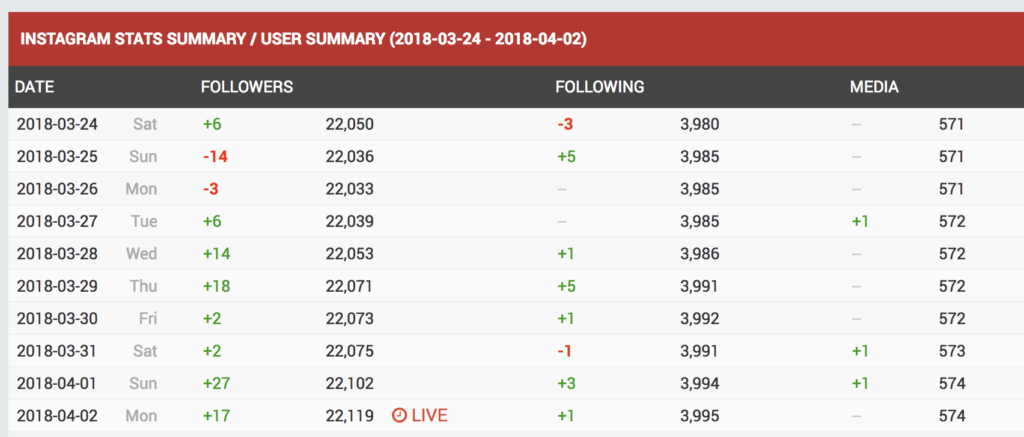Social Blade has become a crucial tool for any marketer who deals with influencers in their business. As I mentioned in my article about how to tell if someone has fake Instagram followers, it is a huge help. But unfortunately about a week ago, that came to a halt without any warning.
Since the Cambridge Analytica scandal (which was actually made public a long time ago but for some reason has only become mass knowledge over the past month), Facebook and Instagram have been implementing changes to the way data can be accessed and used from their platforms. One of these new updates has been to the Instagram API. The API is what developers use to access data from Instagram, and the recent changes have drastically cut the number of calls that can be made per hour down to only 200, from 5,000 previously. Without any warning.
What does this mean for third-party apps and platforms that require access to data and stats from Instagram in order to function? Well, it’s not good. In fact, it means that certain applications can no longer function at all. If we take a look now at Social Blade for Instagram, the last available data was for Monday, April 2nd, 2018.

Social Blade is Broken
Social Blade allowed for more transparency in influencer marketing when it came to Instagram. It meant anyone could access certain insights for anyone else’s account. Very quickly and for free. These analytics provided numbers such as followers gained or lost per day, amount of people they followed or unfollowed per day (which became super important to uncover follow/unfollow tactics), and the number of posts published per day. This was all public information you could technically track yourself anyway if you evaluated an account every day for a period of time.
This meant that a brand or marketer could vet an influencer more thoroughly before deciding to partner with them because it would be easy to see if they had purchased followers. 40,000 followers gained in a day? Oh, okay.

40,000 followers in a day without any content or PR going viral? Hmmm. I don’t think so.
And unfortunately, as per Social Blade’s own Twitter account, there doesn’t seem to be a solution in sight.
To update on the Instagram Stats situation, it appears that for the foreseeable future, Instagram has cut off all developers from accessing follower data. This appears to be in direct correlation to the Cambridge Analytica situation where some third parties have misused data. pic.twitter.com/RUaOEAtHXU
— Social Blade (@SocialBlade) April 5, 2018
On a large scale, it’s still too early to really predict how this is going to affect the landscape of influencer marketing when it comes to Instagram, but it is likely that some brands, influencer agencies, and marketers could want to shift their focus to other platforms where they can still have more transparency and feel better about spending their budgets on a reach that they know for certain is real.
Where to go from here
In the meantime, evaluation of influencers and compensation should now, more than ever before, be based on quality of engagement. I’ve spoken to many marketers who have used influencer marketing to promote an initiative, and more often than not, they say that the total number of followers someone had made little difference. In fact, quite a few found that they got much more out of working with someone who had less than 20,000 followers, than someone with 200,000 followers. I’ve also heard the same about working with an influencer with less than 5,000 followers compared to someone with 20,000 followers. It’s now really all about:
– Brand fit; Does their audience actually care about your product or service?
– How truly engaged their followers are, and;
– Are their followers qualified to actually become a customer of yours? Do they have the money to spend on what you’re offering? Do they live in a market where they can access it?
Of course, the big influencer agencies will now also try to say that they have “the solution” to this issue. However, while they can access data for some influencers, their database is extremely limited, as it is based on having permission from those individual influencers. Most of these agencies have somewhere between 0 – 75,000 influencers on their platform. There are over 800,000,000 users on Instagram. Not to mention that working with these agencies that have these limited databases isn’t cheap. The loss of Social Blade really is a huge hit to transparency, being that it allowed anyone to access anyone else’s data for free.
Overall, I’m very curious to see where this all goes. We all know that companies tend to panic initially when a big scandal hits, so perhaps this change isn’t truly permanent after all. But for now, we shall have to act as though it is.

What a bummer. I really liked Social Blade for the quick possibility to check if people played fair (and worked hard) for their account or they were just massively doing follow-unfollow. Now that’s gone. 🙁